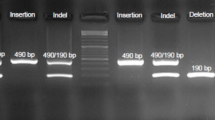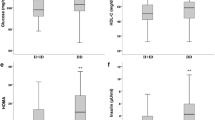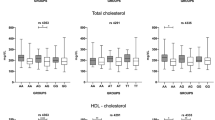Abstract
The present study was designed to evaluate angiotensinogen (AGT) M235T and plasminogen activator inhibitor-1 (PAI-1) (4G/5G) polymorphisims in relation to the occurrence of atherosclerotic renal artery stenosis (ARAS) and recurrent stenosis. In this study, 30 patients were enrolled after angiographic demonstration of ARAS; 100 healthy subjects for AGT polymorphism and 80 healthy subjects for PAI-1 polymorphism were considered the control group. The patients were followed for a mean 46.1 ± 9.2 months. The patients had significantly higher frequencies of the MT genotype and the T allele than control group (χ2 = 18.2, p < 0.001 and χ2 = 11.5 p < 0.001). There were no significant differences in the PAI-1 genotype and allele findings when the data for all patients were compared with that for the controls (χ2= 2.45, p = 0.29 and χ2 = 0.019, p = 0.89). There were no significant differences in the genotype and allele findings for the patients with and without restenosis (p > 0.05). The C-reactive protein (CRP) level was higher in the patients with restenosis than in the patients without restenosis (7.694 ± 0.39 mg/L and 1.56 ± 1.08 mg/L) (p = 0.001). Our results suggest that the M235T MT genotype and T allele might be associated with increased risk of atherosclerotic renal artery stenosis. The CRP level might be an independent predictor for recurrent stenosis.
Similar content being viewed by others
References
Weibull H, Bergqvist D, Jonsson K, et al. (1991) Long-term results after percutaneous transluminal angioplasty of atherosclerotic renal artery stenosis: the importance of intensive follow-up. Eur J Vasc Surg 5(3):291–301
Texto SC (1993) Renovascular hypertension. Curr Opin Nephrol Hypertens 2:775–783
Jeunemaitre X, Soubrier F, Kotelevtsev YV, et al. (1992) Molecular basis of human hypertension: role of angiotensinogen. Cell 71:169–180
Burnier M, Brunner HR (2000) Angiotensin II receptor antagonists. Lancet 355: 637–645
Wong TYH, Chan JCN, Poon E, Li PKT (1999) Lack of association of angiotensin-converting enzyme (DD/II) and among Chinese patients with type II diabetes. Am J Kidney Dis 33:1064–1070
Katsuya T, Koike G, Yee TW, et al. (1995) Association of the angiotensinogen gene T235 variant with increased risk of coronary heart disease. Lancet 345:1600–1603
Nakamura S, Nakamura I, Nishimura H, et al. (1998) Plasminogen activator inhibitor-1 (PAI-1) is induced directly by angiotensin type 1 receptor in vivo. J Am Soc Nephrol 9:523 (abstract)
Fogo AB (2000) The role of angiotensin II and plasminogen actvator inhibitor-1 in progressive glomerulosclerosis. Am J Kidney Dis 35:179–182
Olivieri O, Trabetti E, Grazioli S, et al. (1999) Genetic polymorphisms of the renin-angiotensin system and atheromatous renal artery stenosis. Hypertension 34:1097–1100
Margaglione M, Grandone E, Vecchione G, et al. (1997) Plasminogen activator inhibitor-1 (PAI-1) antigen plasma levels in subjects attending a metabolic ward: relation to polymorphisms of PAI-1 and angiotensin-converting enzyme (ACE) genes. Arterioscler Thromb Vasc Biol 17:2082–2087
Kimura H, Geyjo F, Suzuki Y, et al. (1998) Polymorphisms of angiotensin-converting enzyme and plasminogen activator inhibitor-1 genes in diabetes and macroangiopathy. Kidney Int 54:1659–1669
Kamitani A, Rakugi H, Higaki J, et al. (1995) Enhanced predictability of myocardial infarction in Japanese by combined genotype analysis. Hypertension 25:950–953
Ludwig EH, Borecki IB, Ellison RC, et al. (1997) Associations between candidate loci angiotensin-converting enzyme and angiotensinogen with coronary heart disease and myocardial infarction: the NHLBI Family Heart Study. Ann Epidemiol 7:3–12
Winkelmann BR, Russ AP, Nauck M, et al. (1999) Angiotensinogen M235T polymorphism is associated with plasma angiotensinogen and cardiovascular disease. Am Heart J 137:698–705
Losito A, Parente B, Cao PG, et al. (2000) ACE gene polymorphism and survival in atherosclerotic renovascular disease. Am J Kidney Dis 35(2):211–215
Olivieri O, Grazioli S, Pizzolo F, et al. (2002) Different impact of deletion polymorphism of gene on the risk of renal and coronary artery disease. J Hypertens 20(1):37–43
Bloem LJ, Manatunga AK, Tewksbury DA, Pratt JH (1995) The serum angiotensinogen concentration and variants of the angiotensinogen gene in white and black children. J Clin Invest 95:948–953
Duncan JA, Scholey JW, Miller JA (2001) Angiotensin II type 1 receptor gene polymorphism in humans: physiology and pathophysiology of the genotypes. Current Opin Nephrol Hypertens 10:111–116
Kimura H, Geyjo F, Suzuki Y, et al. (1998) Polymorphisms of angiotensin-converting enzyme and plasminogen activator inhibitor-1 genes in diabetes and macroangiopathy. Kidney Int 54:1659–1669
Hamsten A, Wiman B, Defaire U, et al. (1985) Increased plasma levels of a rapid inhibitor of tissue plasminogen activator in young survivors of myocardial infarction. N Engl J Med 313:1557–1563
Ridker PM (2001) High-sensitivity C-reactive protein: potential adjunct for global risk assessment in the primary prevention of cardiovascular disease. Circulation 103(13):1813–1818
Rattazzi M, Puato M, Faggin E, et al. (2003) New markers of accelerated atherosclerosis in end-stage renal disease. J Nephrol 16(1):11–20
Schillinger M, Exner M, Mlekusch W, et al. (2003) Acute-phase response after stent implantation in the carotid artery: association with 6-month in-stent restenosis. Radiology 227(2):516–521
Bakker J, Goffette PP, Henry M, et al. (1999) The Erasme study: a multicenter study on the safety and technical results of the Palmaz stent used for the treatment of atherosclerotic ostial renal artery stenosis. Cardiovasc Intervent Radiol 22(6):468–474
Acknowledgments
The authors thank Mrs. Yasemic Genc (PhD), Department of Biostatistics, Ankara University Faculty of Medicine, for her help with the statistical analysis.
Author information
Authors and Affiliations
Corresponding author
Rights and permissions
About this article
Cite this article
Reis, K.A., Onal, B., Gonen, S. et al. Angiotensinogen and Plasminogen Activator Inhibitor-1 Gene Polymorphism in Relation to Renovascular Disease. Cardiovasc Intervent Radiol 29, 59–63 (2006). https://doi.org/10.1007/s00270-005-0072-6
Published:
Issue Date:
DOI: https://doi.org/10.1007/s00270-005-0072-6




